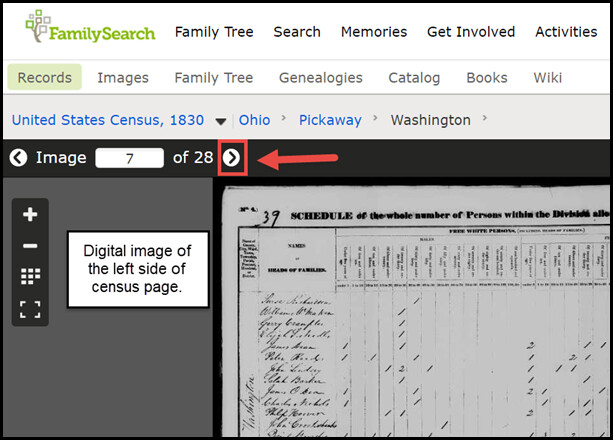The United States of America began federal enumerations in 1790. The 1830 U.S. census form was the first census form uniformly printed. Even though this census doesn’t hold the names of every individual in the household, a wealth of information can still be extracted.
One Form on Two Pages
Different censuses, sometimes called population schedules, asked different questions. Depending on the number of questions asked, the census form might be very wide. When the census was wide, digitizers were forced to make 1 census page into 2 digital images. The first digital image was the left side of the census page, and the second digital image was the right side of the same census page. This was the case with the 1830 U.S. census form.

In the 1830 census, the first digital image of a census page, or the left side, included the names of the heads-of-household and age, race, and gender columns for White persons. You may have noticed there were no other names of persons recorded for a household except that of the head of household. Instead, a “tick mark” or number was placed in the appropriate age and gender columns to refer to an individual. The age brackets for White persons were quite extensive.
The second digital image of the census page, or the right side of the page, can be found by clicking the right arrow key at the top of the film browser. That side of the page is where the enslaved and Free People of Color age categories were listed.
Though the age brackets for the enslaved and Free People of Color were also extended from 4 brackets in the 1820 U.S. census to 6 in 1830, there were not as many age categories as offered in the White age brackets.
How to Read the 1830 U.S. Census Form
One “tick mark” or number in a bracket indicated the age, race, and gender of a person within the household. For example, in the census below, Andrew Blue’s household has 2 White males under the age of 5 years; 1 White male between the age of 5 to 10 years; 1 White male between 30 to 40 years; 1 White female between the age of 5 to 10 years; and 1 White female between 20 and 30 years. You may assume that the minors are the children of Andrew Blue and the oldest female you might suppose to be his wife. Be careful. Not everyone living in the household might have been a blood relative!

New Questions Asked on the 1830 U.S. Census Form
1830 U.S. Census Age Brackets (Enslaved and Free People of Color)
- under 10 years
- 10 to 24 years
- 24 to 36 years
- 36 to 55 years
- 55 to 100 years
- 100 years and upward
The 1830 U.S. Federal Census was the first U.S. census to ask questions regarding health. For all White, enslaved, and Free Persons of Color, each household was asked if there were any who were deaf and dumb in 3 age brackets. Those age brackets were under 14 years; 14 to 25 years; and 25 years and upwards. A question regarding blind persons was not divided into age brackets. These questions can be found on the right side of the census page.
Lastly, the 1830 U.S. census asked whether any persons were foreigners who were not naturalized. The answer to this question may indicate that you should look for additional records such as passenger lists or naturalization records. This question can also be found on the right side of the census page.
- Under 5 years
- 5 to 10 years
- 10 to 15 years
- 15 to 20 years
- 20 to 30 years
- 30 to 40 years
- 40 to 50 years
- 50 to 60 years
- 60 to 70 years
- 70 to 80 years
- 80 to 90 years
- 100 years and upward
Downloading and Using the 1830 U.S. Census Form
You can download the 1830 U.S. census form in PDF form here to help you with your research. These blank census forms allow you to record information about your ancestral family and then review it quickly and easily.
You can find your own ancestors in 1830 census records using a free FamilySearch account. Click on the link below to get started, or learn more about the 1830 census on the FamilySearch Blog.


